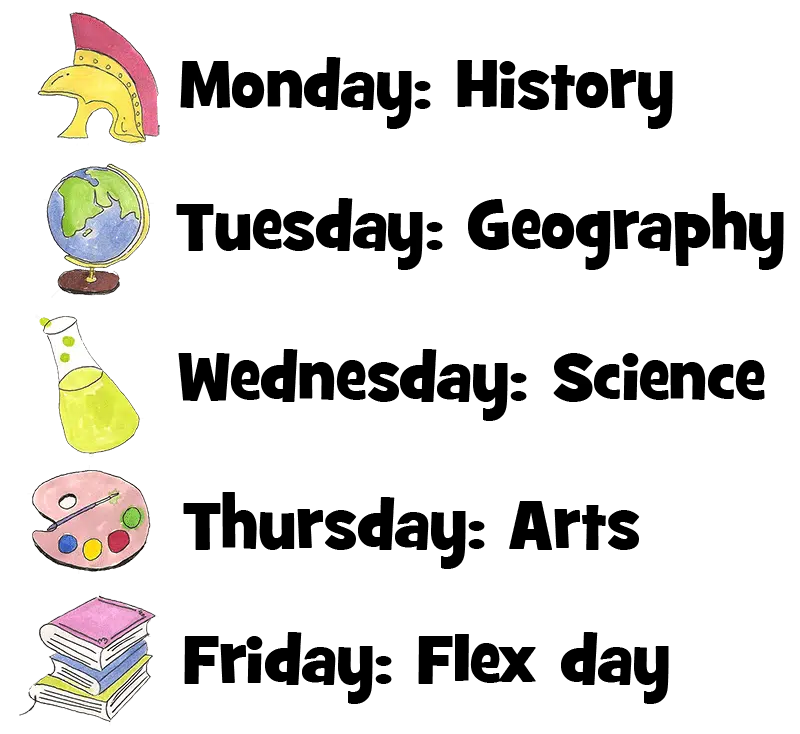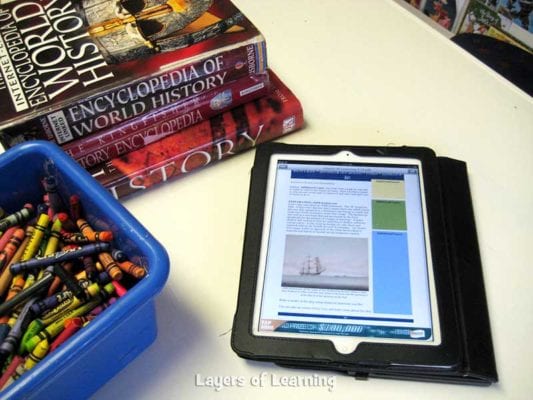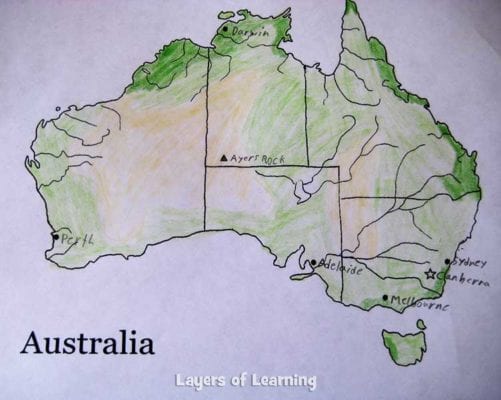Have you wondered what a week with Layers of Learning looks like? Join us for a springtime week in our homeschool. And if you aren’t familiar with the Layers of Learning curriculum, take a quick peek at our of Layers of Learning Curriculum Guide to learn more about it.
A Week With Layers of Learning at our House
Layers of Learning is flexible; it can be used any way that suits your family, but we use a Subject-of-the-Day schedule. This is what a week with Layers of Learning looks like at our house.

Besides our weekly subject rotation, we do daily work – math, writing, and reading. Some of my kids are also doing foreign languages, music lessons, and other elective classes. But for now, we’ll just look at what the Layers of Learning portion of our week looks like.
Monday
On Mondays we do history. This week we’re learning about the Exploration of the South Seas.
First, I look through the current unit and choose books. I put these on hold at the library a week in advance or pull them off my shelf and put them in our book basket.

I choose the specific explorations I want to do with my kids. Today I decide we’re going to do a timeline and a narration of Exploring the South Seas. I print the timeline squares and bring my iPad to the table.

Introduction and Timeline
We start off by reading the introduction to the unit out loud together.

Then we’re ready to do our timeline. We have a long paper timeline on the wall in our schoolroom. I used a roll of freezer paper, drew a straight thick black line the long way down the center and then divided it into time increments. This year we’re studying the colonial period and we’re covering from roughly 1400 to 1800.
As the kids add things to the timeline we discuss them. I act a little silly sometimes and do a bit of drama for them. Today I tell them stories I know, like the time Captain Cook was shipwrecked on the Great Barrier Reef or the time our family went to the site where Captain Cook was killed in the Hawaiian Islands. And then I ask them questions and let them talk about what they know.
Reading & Narration
Next, I send my two high schoolers off to read more in History from DK, my fifth grader to read more in Kingfisher History Encyclopedia, and I read from Usborne Encyclopedia of World History with my 3rd grader, 1st grader, and preschooler.

The kids write narrations about what they read. 
Here is Isaac’s narration:

Next week we’ll continue to learn about the South Seas. We’re going to explore several websites about Captain Cook, which are linked to from the sidebars, draw our own map of a mysterious Southern Continent, and use Captain Cook’s actual chart to follow his journeys across the South Seas, pasting on images from his voyages. All through the two weeks, the kids will also be reading library books on the topic during their reading time.
Tuesday
Now it’s Tuesday – geography day. We are studying Australia and New Zealand.
First, I looked through the unit and decided to do a map of each country and look at a few links – one about aboriginal art and one about the didgeridoo, a native Australian instrument.
We looked at our globe and our wall map of the world and found Australia and New Zealand. Then I told the kids to use their atlases and color and add details to their maps from the printable pack.

The kids searched through their atlases and added all sorts of things to their maps. Meanwhile, I read them some interesting facts from the unit sidebars and we all talked about Australia and New Zealand.

As in history, I have three different levels of atlases for my kids. The youngest kids use My First Atlas from Hammond and the middle grades kids use Student Atlas from DK. Meanwhile, my high schoolers use the World Atlas from DK.

Next week we’re going to play a matching game with Australian animals and then make animal posters.

Wednesday
We are just finishing up our study of rocks, and fossils are the last topic. I started by looking over the Layers Curriculum and picking out an experiment on permineralization.
We read the fossil introduction from Layers of Learning and then made “sponge fossils.” This experiment shows how once-living material, like an animal bone, becomes filled with minerals. In fact, the minerals replace the bone. This is called permineralization.
We soaked our sponges in Epsom salt water. We poured off the water and then let the sponges dry for several days. They became hard as a rock. Real fossils also become rock as minerals replace the organic material.
The chemical name of Epsom Salts is Magnesium Sulfate (MgSO4). During the experiments, I try to remember to say “Magnesium Sulfate” instead of just Epsom Salts.
We read some books about fossils from the library. My high school boys also read the “Geology: A Self Teaching Guide” this year for a full high school credit course.


An Expedition
We recently went on a field trip to Stonerose, a place in Washington State where you can search for your own fossils. We also did a field trip to Emerald Creek National Park in Idaho where you can search for star garnets.

We came loaded up with gems and the boys decided mining is hard work.

A week with Layers of Learning doesn’t always include an expedition, but we love to take advantage of any learning opportunities beyond the walls of our home when we can.
Thursday
Thursday is art day! This week we’re learning about principles of art, including things like balance and proportion. After we learn about the principles we practice with our own drawings. Each of my kids, kindergarten through high school have the same assignment. Today they are to focus on balance in their pictures as they draw a sketch of their choice in their sketchbooks.
Harrison is using a how-to-draw a picture of Captain Cook on the deck of his ship with an island in the background. This ties back in with what we are learning about in history this week.

We pull out the how-to-draw books, the colored pencils, crayons, sharpeners, and paints for the two youngest who insisted on painting.
Friday
Friday is our flex day. The Layers of Learning Homeschool Curriculum includes four major subjects: History, Geography, Science, and Arts. That means that if you do one subject a day through your week, you’ll have a flex day. You might think it’s a do-nothing day, but in fact, it is the most important day in our homeschool. It’s our day for field trips, homeschool friends, and catch up work. But it is also an extra day for us to review what we’ve learned in our unit and throw in an extra exploration or two from a subject we enjoyed this week.
This Friday I decided to do an Aboriginal art project from the geography unit we did on Tuesday. By the time we had finished with the maps on Tuesday our time for geography was up, but this project looked like fun.

A link from the sidebar of the unit led us to some real Aboriginal art. We noticed how they use dots to make the shapes in the art. Then I gave each of the kids the printable kangaroo outline from the unit and they filled it in with dots. And even after our math, reading, and writing, we still had a whole glorious afternoon for reading books from our library basket.
And that’s it for our week with Layers of Learning.
More From Layers of Learning
Go check out our catalog to try one of our units.
Get a Free Unit
Choose between the first unit in each Layers of Learning subject to try for free when you sign up for the newsletter.
We never spam and you can cancel your subscription at any time.










I just found you blog. I love how organised you are. I am new to homeschooling this year and you are a great inspiration. Thank you!
Welcome to homeschooling Krista! We hope it brings you as much happiness as its brought us! So glad you found us. All the best in your homeschooling adventures!
How much time do you assign for reading each day?
It depends on the ages of the children and your needs. I assign 30 minutes of independent reading each day and then also read aloud for 15 to 20 minutes, or the length of one chapter.